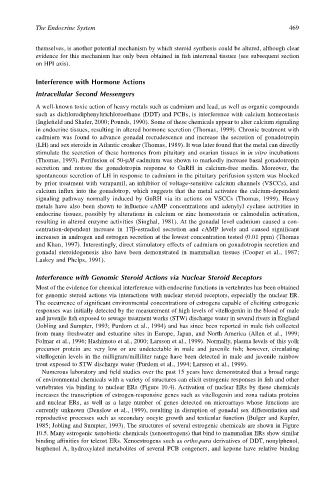Page 489 - The Toxicology of Fishes
P. 489
The Endocrine System 469
themselves, is another potential mechanism by which steroid synthesis could be altered, although clear
evidence for this mechanism has only been obtained in fish interrenal tissues (see subsequent section
on HPI axis).
Interference with Hormone Actions
Intracellular Second Messengers
A well-known toxic action of heavy metals such as cadmium and lead, as well as organic compounds
such as dichlorodiphenyltrichloroethane (DDT) and PCBs, is interference with calcium homeostasis
(Inglefield and Shafer, 2000; Pounds, 1990). Some of these chemicals appear to alter calcium signaling
in endocrine tissues, resulting in altered hormone secretion (Thomas, 1999). Chronic treatment with
cadmium was found to advance gonadal recrudescence and increase the secretion of gonadotropin
(LH) and sex steroids in Atlantic croaker (Thomas, 1989). It was later found that the metal can directly
stimulate the secretion of these hormones from pituitary and ovarian tissues in in vitro incubations
(Thomas, 1993). Perifusion of 50-µM cadmium was shown to markedly increase basal gonadotropin
secretion and restore the gonadotropin response to GnRH in calcium-free media. Moreover, the
spontaneous secretion of LH in response to cadmium in the pituitary perifusion system was blocked
by prior treatment with verapamil, an inhibitor of voltage-sensitive calcium channels (VSCCs), and
calcium influx into the gonadotrop, which suggests that the metal activates the calcium-dependent
signaling pathway normally induced by GnRH via its actions on VSCCs (Thomas, 1999). Heavy
metals have also been shown to influence cAMP concentrations and adenylyl cyclase activities in
endocrine tissues, possibly by alterations in calcium or zinc homeostasis or calmodulin activation,
resulting in altered enzyme activities (Singhal, 1981). At the gonadal level cadmium caused a con-
centration-dependent increase in 17β-estradiol secretion and cAMP levels and caused significant
increases in androgen and estrogen secretion at the lowest concentration tested (0.01 ppm) (Thomas
and Khan, 1997). Interestingly, direct stimulatory effects of cadmium on gonadotropin secretion and
gonadal steroidogenesis also have been demonstrated in mammalian tissues (Cooper et al., 1987;
Laskey and Phelps, 1991).
Interference with Genomic Steroid Actions via Nuclear Steroid Receptors
Most of the evidence for chemical interference with endocrine functions in vertebrates has been obtained
for genomic steroid actions via interactions with nuclear steroid receptors, especially the nuclear ER.
The occurrence of significant environmental concentrations of estrogens capable of eliciting estrogenic
responses was initially detected by the measurement of high levels of vitellogenin in the blood of male
and juvenile fish exposed to sewage treatment works (STW) discharge water in several rivers in England
(Jobling and Sumpter, 1993; Purdom et al., 1994) and has since been reported in male fish collected
from many freshwater and estuarine sites in Europe, Japan, and North America (Allen et al., 1999;
Folmar et al., 1996; Hashimoto et al., 2000; Larsson et al., 1999). Normally, plasma levels of this yolk
precursor protein are very low or are undetectable in male and juvenile fish; however, circulating
vitellogenin levels in the milligram/milliliter range have been detected in male and juvenile rainbow
trout exposed to STW discharge water (Purdom et al., 1994; Larsson et al., 1999).
Numerous laboratory and field studies over the past 15 years have demonstrated that a broad range
of environmental chemicals with a variety of structures can elicit estrogenic responses in fish and other
vertebrates via binding to nuclear ERs (Figure 10.4). Activation of nuclear ERs by these chemicals
increases the transcription of estrogen-responsive genes such as vitellogenin and zona radiata proteins
and nuclear ERs, as well as a large number of genes detected on microarrays whose functions are
currently unknown (Denslow et al., 1999), resulting in disruption of gonadal sex differentiation and
reproductive processes such as secondary oocyte growth and testicular function (Bulger and Kupfer,
1985; Jobling and Sumpter, 1993). The structures of several estrogenic chemicals are shown in Figure
10.5. Many estrogenic xenobiotic chemicals (xenoestrogens) that bind to mammalian ERs show similar
binding affinities for teleost ERs. Xenoestrogens such as ortho,para derivatives of DDT, nonylphenol,
bisphenol A, hydroxylated metabolites of several PCB congeners, and kepone have relative binding

